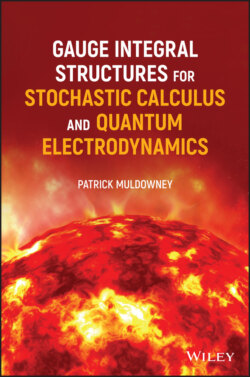Читать книгу Gauge Integral Structures for Stochastic Calculus and Quantum Electrodynamics - Patrick Muldowney - Страница 20
Example 3
Оглавление
Throw a pair of dice and, whenever the sum of the numbers observed exceeds 10, pay out a wager equal to the sum of the two numbers thrown, and otherwise receive a payment equal to the smaller of the two numbers observed. If the two are the same number (with sum not exceeding 10) then the payout is that number.
In Example 3 take sample space
Observation of a throw of the pair of dice can be represented by a listing of the possible joint outcomes , , . Define a random variable by
for each . Then, as in the previous example where the domain and range of are finite sets, is ‐measurable and qualifies as a random variable, with expected value
The integral in this case reduces to the sum of a finite number of terms.
The payoff from the wager in Example 3 is a randomly variable amount given by
In this case, is a composite of the deterministic function with the random variable ; and, just like , is (trivially) ‐measurable, and is a random variable, with
where, again, the Lebesgue integral reduces (trivially) to a finite sum of terms.
There are many alternative ways of representing mathematically the unpredictable payout of this wager, as the following illustration shows. The outcome of the wager is the value , where
Examining each of the 36 pairs in (, ) in turn, the outcomes or payouts are listed in Table 2.1.
For instance, of the 36 possible pairs of throws , a loss of 11 is incurred twice, with throws of (5,6) and (6,5).
Accordingly, let the sample space for the wager be
let the measurable sets consist of , the family of all subsets of , and, for let be as set out in Table 2.1; so, for , can be found by adding up the relevant probabilities in Table 2.1.
Table 2.1 Distribution of payouts.
| Payout | Probability |
|---|---|
| 1 | |
| 2 | |
| 3 | |
| 4 | |
| 5 | |
| ‐11 | |
| ‐12 |
Now define random variable by the identity mapping for . Trivially, is ‐measurable, and
or slightly more than 1 euro.
The random variables and are two equivalent ways of mathematically representing the wager. In [MTRV], is described as a contingent form of the random variable, while is an elementary form.
Measurability ensures that the two forms are related. To illustrate, consider , a subset in the range of the random variable (or . Then
which is a subset of the sample space . Both and are measurable sets (trivially), and is a measurable function, with
This kind of relationship is generally valid for contingent and elementary forms of random variables.
